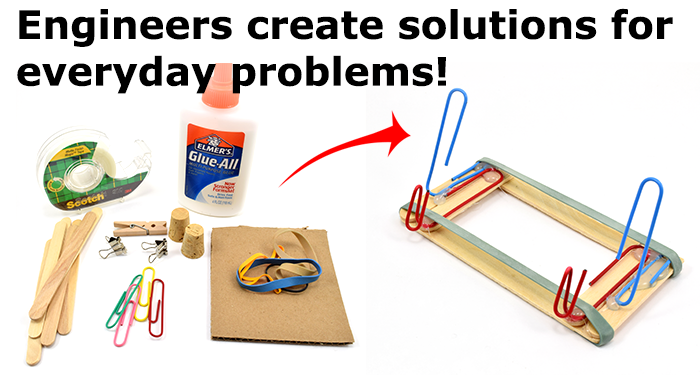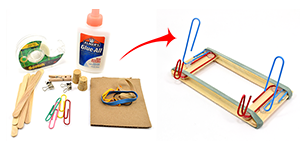Engineering a Solution to an Everyday Problem
For Science Buddies' scientists, everyday challenges provide inspiration for student STEM projects.

Engineers create solutions for everyday problems!
Scientists and engineers don't always leave their work at the office at the end of the day. Many scientists think like scientists all the time. It is how they approach the world both at home and at work. They ask questions. They form hypotheses. They set up experiments. They analyze data. (See the scientific method.) Engineers, too, go through their days with an engineering mindset, at home and at work. They see problems. They brainstorm solutions. They innovate. They create. They test their designs, and when things don't work or could be better, they try again. (See the engineering design process.) Engineers know that by brainstorming, problem solving, and testing, they can solve problems, create exciting new things, or improve upon things that already exist.
Think Like a Scientist!
Science and engineering is everywhere, and scientists who work at Science Buddies believe that students learn more and are more excited about science, technology, engineering, and math (STEM) when they have opportunities to explore STEM with hands-on projects and activities they can relate to the real world and to their own lives. Sometimes, this means that our scientists and engineers write projects that relate to science in the news (like flu season) or to exciting science fields (like nanotechnology or agricultural technology). Our scientists get excited about bringing all kinds of science explorations to life for students, like investigating iron, gluten, or glucose content in foods; building an ArtBot; making crystals; cleaning pennies; measuring electrolytes in juices; toy boats; or exploring paper circuits, paper roller coasters, and paper speakers.
We have more than 1,100 project ideas at Science Buddies, and our scientists are always thinking of exciting ideas for projects and activities that students can do to explore science questions. Our scientists are experts. They know the science that teachers cover and that students learn in K-12 classes, and they write cool hands-on projects and activities to help students explore all kinds of STEM subjects that you expect to find when searching for science projects. Because they are really enthusiastic about science and engineering, our scientists also have lots of ideas for unusual STEM projects and activities for students, too! They see science and engineering potential all around them, and they want students to see that way, too.
Sometimes developing ways for students to get excited about science means that our scientists spend time thinking about crazes and fads that are popular with K-12 students—like fidget spinners, Laurel vs. Yanni, LED throwies, baked ice cream cake, or homemade juice balls. Our scientists pay attention to what kids are talking about and think about the STEM principles at work and how students can learn more about science by doing related experiments. Some of our STEM project ideas and activities are created specifically to help students dig deeper into the science of whatever is cool right now at school. Other projects and activities are created as a result of our scientists and engineers being scientists and engineers at home, too.
So when you work at Science Buddies, and you want to find a way to make sure your tree doesn't dry out during the holiday season, not only do you make your own light-up ornament with a sensor-based circuit to alert you when the tree needs water, but you do it as an extension of an electronics project you wrote for students. You add cute eyes to go along with the light-up reindeer nose, and you take photos to help inspire kids to get creative with their electronics and build circuits that can be put to use at home.
So what happens when you buy a new phone and need a new cell phone holder for your car? If you are an engineer at Science Buddies, you might just make your own and then turn the challenge into a project for students, too!
Engineering for Everyday Use
A few months ago, Ben Finio, Senior Staff Scientist at Science Buddies, got a new cell phone. He had been using a 3D-printed phone holder that he had designed for his previous phone, but it didn't fit his new phone. After looking at what was available, readymade, in stores, he couldn't find exactly what he wanted. He identified his needs. He needed a holder that would fit his phone and sit securely in his car where it would be visible while driving. He identified the problems he saw with other designs. For example, he didn't want to obstruct his view by using suction cups attached to the window, and he didn't trust suction cups to hold securely on the dashboard. Nothing he saw or tried exactly matched what he wanted, so he did what any engineer might do and made his own.
Putting the engineering design process in action, Finio built his own cellphone holder with popsicle sticks, paper clips, rubber bands, and glue. But he didn't stop there. As a Science Buddies scientist, Finio wants to inspire students to see science and engineering as relevant in their own lives and to explore science and engineering in concrete and creative ways. He took his own experience looking for a cell phone holder for his car and turned it into a STEM activity for students.
"My cell phone holder gets the job done, but there is definitely room for improvement," says Finio. "I am sure that students who try the project will come up with their own ideas for ways to make a cell phone holder like this even better."
What project will Finio write tomorrow? It might depend on what problem he runs into between now and then!
Try an Engineering Project
In addition to the cell phone activity, students interested in engineering and innovation may want to try fun engineering challenges like these:Or, experiment with engineering design with projects like these:
- Crash! Can Cell Phones Survive a Drop Test?
- Get Crafty — Create Your Own Durable Paper Doll
- Grasping with Straws: Make a Robot Hand Using Drinking Straws
Careers in Engineering
Students who love to come up with their own inventions and design their own solutions may also enjoy engineering in the future. Students can learn more about popular engineering careers in the Careers in Science area at Science Buddies. For example:










